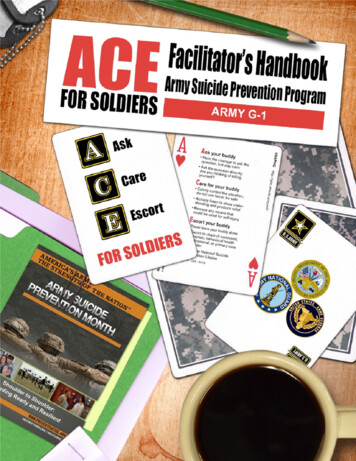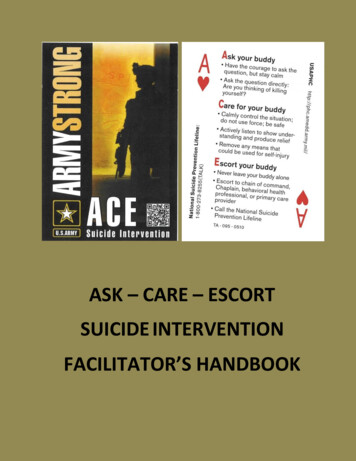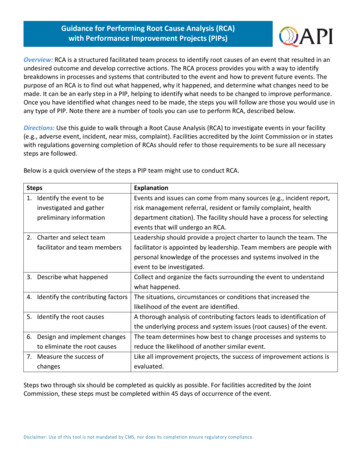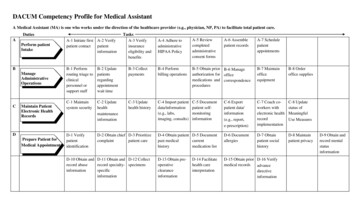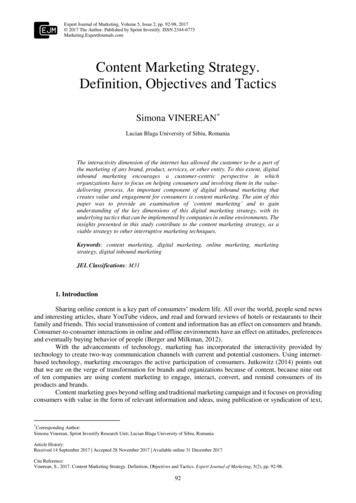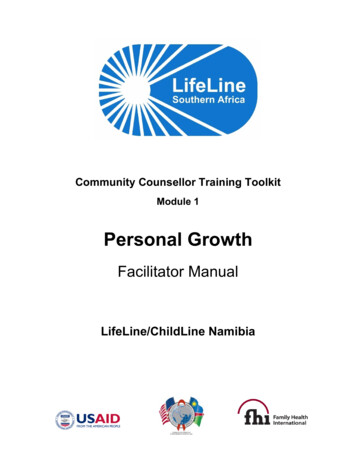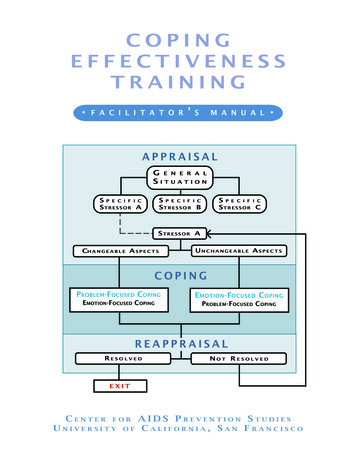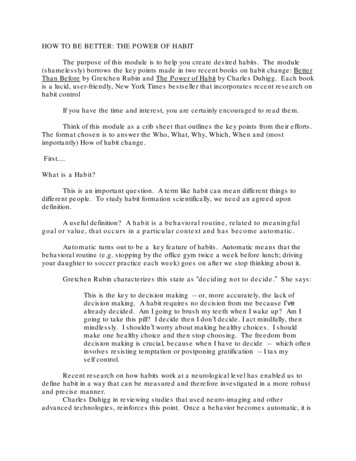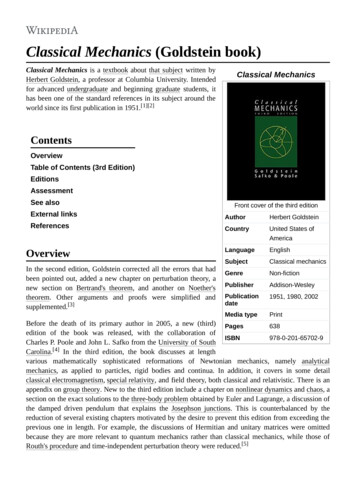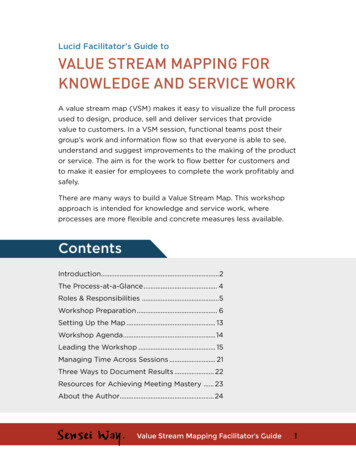
Transcription
Lucid Facilitator’s Guide toVALUE STREAM MAPPING FORKNOWLEDGE AND SERVICE WORKA value stream map (VSM) makes it easy to visualize the full processused to design, produce, sell and deliver services that providevalue to customers. In a VSM session, functional teams post theirgroup’s work and information flow so that everyone is able to see,understand and suggest improvements to the making of the productor service. The aim is for the work to flow better for customers andto make it easier for employees to complete the work profitably andsafely.There are many ways to build a Value Stream Map. This workshopapproach is intended for knowledge and service work, whereprocesses are more flexible and concrete measures less available.ContentsIntroduction.2The Process-at-a-Glance. 4Roles & Responsibilities .5Workshop Preparation. 6Setting Up the Map. 13Workshop Agenda.14Leading the Workshop. 15Managing Time Across Sessions. 21Three Ways to Document Results. 22Resources for Achieving Meeting Mastery . 23About the Author. 24Value Stream Mapping Facilitator’s Guide1
INTRODUCTIONThe purpose of a value stream map is to engage knowledgeable staffand stakeholders in visualizing the work and applying lean principlesto a full product or service flow. Value stream mapping can identifyways to eliminate waste, outline technology projects, surface neededpolicy shifts or charter new breakthrough process redesigns andopportunities for automation.This guide walks you through the creation of a current state ValueStream Map (VSM) and identification of both kaizen “quick win”changes and big change projects. A current state VSM shows theprocess as it works today, reviewing a recent experience or a specificcase, not as it worked in the past nor how we might wish it to workin the future.Stepping back from a VSM, people can see a workflow and oftengrasp its full scope for the first time. They discover workflowbottlenecks or disconnects, and transfers between groups thathinder progress. They can identify lost time, defects and the “churn”of rework. They may see opportunities to help people downstreamof them or inform those upstream of their needs or timing. It isoften best to map an actual recent case of service or knowledgework, such as the last product designed or the last service offeringdelivery.Creating a Value Stream Map for knowledge and service workrequires a different approach than the VSM work conducted in amanufacturing environment. Strict measurements of time, inventory,and quality usually aren’t automatically captured as metrics forknowledge and service work as they are in manufacturing, butthey may be collected or estimated. Those aspects of value streammapping are de-emphasized here.Value Stream Mapping Facilitator’s Guide2
A VSM for knowledge and service work focuses more closely oninformation flow. Does the information arrive and flow in a formatthat all groups can use, or are there wasteful translations happeningfrom group to group? Is missing approval or incomplete informationcausing delays and rework? Are there points in the flow where lackof clear ownership or misunderstandings result in quality problems?Expect to spend 3 to 6 weeks planning the VSM workshop. Theworkshop itself takes at least 4 hours to complete, and may extendover several days. Afterwards, the group will plan a series of followup meetings and new projects to implement the recommendationsmade during the workshop.Groups that will find this guide useful include: Leaders interested in continuous improvement and leanoperations redesign in mid-sized to large organizations Business units where multiple departments or functional groupsweave their work together to deliver a product or service Those struggling to tame a variable or wasteful process and noone owns the whole of it Business units preparing the launch of a new product or servicethat will involve multiple departments or functional groupsValue Stream Mapping Facilitator’s Guide3
The Value Stream Mapping Workshop Process-at-a-Glance1. Define the project charterand deliverables, then setup a blank map with swimlanes for each functionalgroup involved in theprocess to be mapped.Mark a rough processtimeline across the top.TimelineProcess Start12Process End345Group 4Group 3Group 2Group 1Measures (if any)2. Functional groupspopulate the swimlanes with the tasks step 1 ,decisions, andwork in process inventoriesthey complete as partof the process. Each groupuses a different color.TimelineProcess Start12Group 4step 1Group 3step 1Group 2Group 1Process Endstep 35step 4step 5step 3step 2step 24step 2step 2step 1step 13step 3step 4step 3step 4step 4step 5step 5step 6step 6step 7step 8Measures (if any)3. Group leaders explainthe tasks in their lane.Participants write downperceived issues on a redsticky, and place these onthe map.TimelineProcess StartGroup 4step 1Process Endstep 2step 3step 4!!Group 3step 1Group 2step 2step 1step 1Group 1step 2!step 2step 5!step 3step 4!!step 3step 4step 5!!step 3step 4!!!step 5step 6!!step 6step 7!step 8!Measures (if any)4. Team leads andfunctional groups drawlines showing dependenciesbetween tasks, decisionsand inventory, and placegreen stickies withproposed solutions on themap. Participants agreeon “bursts” or big changesneeded, and prioritizekaizen quick wins, thegreen sticky notes.TimelineProcess StartGroup 4step 1Group 1step 2step 3!:) !Group 3Group 2Process Endstep 1step 1step 1step 3:) !step 4!step 2step 2step 5!:) :)step 2!step 4:)step 3step 3step 4!:) ! :) !!step 5!step 4step 5!:) !!:)step 6step 6!step 7!:)step 8!Measures (if any)Value Stream Mapping Facilitator’s Guide4
Roles & ResponsibilitiesVSM Workshops involve the people who supervise and conduct thefunctional work, the subject matter experts who support it, and mayalso include customers and suppliers if warranted.Facilitator Manages the workshop preparation, process, and dialogue Assists with workshop documentationExecutive Sponsor Authorizes the time, budget and organizational backing forthe project Presents a “state of the business” or “burning platform”address to kick-off the workshop Resolves political disagreements in order to get the specificfollow-up improvement actions completed by the ownersChampion Defines the workshop charter and participants, and securesthe workshop location and supplies Manages initial communication and invitations to workshopparticipants Shows purpose and a passion for the project andcommunicates to participants throughout the project life Convenes governance follow-up meetingsFunctional LeadersFunctional leaders may be assisted by knowledge workers, decisionmakers, and others from their group. Prepare and present level-setting presentations Populate and present VSM swim lanes Participate in the process critique and solution identification Take responsibility for completion of assigned follow-upactivitiesFacilitator’s Assistant Manages workshop technology, room setup, and supplies Assists with workshop breakout sessions (if any) anddocumentationValue Stream Mapping Facilitator’s Guide5
WORKSHOP PREPARATIONPreparation begins with one or more meetings between theworkshop facilitator, the champion, and the executive sponsor.Together, you’ll define the workshop charter, get the participantsorganized, and make sure everything is ready for a successfulworkshop.Pre-WorkshopInitial Planning MeetingThe facilitator schedules and leads the pre-workshop meetings.Identify Problem to SolveReview Project Charter FormQuick Review of Value Stream MappingProcess by Facilitator (if necessary)ClosingValue Stream Mapping Facilitator’s Guide6
For the first discussion, meet with the champion and executivesponsor to clarify the problem to solve. Typically the questions toanswer are, “Why do a VSM?” and “Why Now?” If these problemsare limited to a local work center, hold a kaizen event meeting ratherthan a full VSM.Only operations issues are appropriate for a VSM meeting.VSMs are NOT an appropriate way to solve complex issues related tostrategy, leadership, policy, or culture.Validate that the champion and sponsor are targeting an operationalissue.For example, a VSM for knowledge work can help identify problemsthat arise when different groups need to share information,highlighting opportunities to standardize the way information isstored and formatted.Or, service organizations might use a VSM to find times when acustomer is left waiting too long, and work to eliminate delays in thework process, a common example in hospital emergency rooms.After clarifying the operations issue, review the project charter form(see details on the next page) and discuss the workshop purpose,scope, target date and time allocation for the event. A VSM requirescross-functional flow and collaboration, so it’s important that allfunctional leaders buy in to the need for a full VSM and attend.Note: If the champion cannot get buy-in from key functional leaders,elevate the disagreement to the higher sponsor to resolve thesecommitment issues and consider delaying the workshop, or reducingthe scope to those who agree. The coach or facilitator should nevertake the role of sponsor, as s/he will usually lack the line authority toimplement kaizen quick wins or big changes.Decide also if it make sense to collect task measures of job cycletimes, total lead time through to completed result to a customer,wait times, and similar quality measures.These measures aren’t often automatically collected for knowledgeor service work, but if they will be useful here, decide that up front.These measures can also just be estimated within the process to givea qualitative sense of the room for improvement.Value Stream Mapping Facilitator’s Guide7
Creating the Workshop CharterA value stream mapping workshop charter and planning sheet lays outthe details the champion needs to think through for the workshop tosucceed. Download a blank Word version of the charter form or-guides/Blank%20Workshop%20Charter.docThe charter covers these details: The need or problem statement Goals and deliverables What’s “in scope” and “out of scope”, getting specific about theprocess boundaries. A full VSM always begins with suppliers andends with customers. A smaller segment is a “process map” not aVSM. Identified team leads for each function in the value stream flow The participant list, both for in-person and remote participants The anticipated time needed for each section of the work session Supplies list and/or online toolkitSupplies for In-Person Workshops Equipment for Remote Workshop One or more whiteboards withmarkers Video conferencing service(ideal) or conference calling Roll of banner, plotter orbutcher block paper andnarrow painter’s tape formarking work streams Collaborative visual mappingsoftware(iObeya, IdeaFlip, Mural, orsimilar) Post-it Notes: Multiple colors(6 - 8); along with the red“waste” post-its and green“ideas” post-its SharpiesLucid Meetings or similar formanaging time, capturingnotes, sharing presentations,and keeping the process ontrack Computer and projector forsharing presentations, takingnotes Timer Snacks!!Value Stream Mapping Facilitator’s Guide8
After reviewing the elements of the charter, the facilitatordemonstrates a simplified version of the value stream mappingmethod to help everyone understand how to fill out post-it notes,and secure participant commitment. Use post-it notes to illustrate asimple process, such as one individual driving to work.To close the meeting, ask for any final questions and confirm nextsteps.Expected Next Steps after the Initial Planning Meeting The champion should commit to a due date for completingthe workshop charter. The champion and facilitator should set the next meetingdate.Pre-WorkshopPlanning Meeting 2Review and Refine CharterClarify Participants and Pre-WorkDiscuss ConcernsDefine Schedule5ClosingOnce the champion defines the workshop charter, agenda, andparticipant list, meet to review and refine the details.Value Stream Mapping Facilitator’s Guide9
During the charter review, consider: Does the agenda reflect the charter’s problem statement, thedeliverables, and time constraints? Are all the key stakeholders on the participant list? Can the VSM workshop be completed effectively within timeconstraints? If not, you will need to extend to multiple sessions orreduce scope.When you’re happy with the charter, clarify who needs to give levelsetting presentations at the beginning of the workshop and whatthey need to cover.About Level-Setting PresentationsLevel-setting presentations provide importantbackground information about each functional groupparticipating in the VSM workshop. The goal: provideenough context to prevent obvious questions lateron. Presenters should plan to talk for no more than 15minutes.Level-setting presentations include: A brief explanation of what that function does;mission, charter, key projects/initiatives, etc.,focusing on how they are players in the VSMprocess. Notes about key challenges and constraintsimpacting work on this value streamAsk presenters to minimize the number of slides andavoid small fonts or tables that are “eye charts” on thescreen. If tables and charts are required, provide thoseas separate handouts.Once the participant list looks good, surface and discuss any ofthe key players’ doubts or misconceptions about what the VSMworkshop will accomplish and the time and effort it will require tobe successful. They should be aware that both quick wins and bigchanges will be required, and big changes such as new technologycould require funds and weeks or months to complete.Value Stream Mapping Facilitator’s Guide10
Then, decide if the VSM should be broken into multiple 4-hoursections on different days for ease on peoples’ schedules. This alsoallows for data to be gathered or confirmed between sessions, forsub-groups to work on identifying solutions, and helps participantsreturn fresh for day two.Select multiple possible target dates that you can check againsteveryone’s availability.Expected Next Steps after Planning Meeting 2 The champion should review the VSM charter with the keystakeholders before the workshop. Finalize agreement on a specific, recent knowledge work case orservice offering that’s to be the focus of the “current state” map. Identify an internal support person to help the facilitator withlogistics such as hanging paper, making swim lanes, taking notes,managing the technical capabilities for on-line participants, andproducing a final report if needed. Ask the sponsor to plan a “state of the business” or “burningplatform” address to kick off the meeting. It should present thelogic and data to the group on “why change?” at this time. The champion should send email to participants defining VSMpre-work, including creation of level-setting presentations.Final Pre-Workshop Check-InMeet briefly with the champion a few days before the workshop tocheck for any changes that would impact the workshop’s success.Look for changes in: The workshop charter Attendees Level-setting presentations Logistics Disruptive outside eventsValue Stream Mapping Facilitator’s Guide11
Identify possible breakout sessions.Are there obvious known problems with the current process? If youknow there will be topics that require focused work, plan breakoutteams to work these topics later in the workshop and anticipate thebest assignment of key individuals to them. Similarly anticipate bestteam leads for potential break-out topics.Finally, confirm that the organization still has the managementcapacity to support follow-up on the VSM action list.Sometimes a new business challenge arises and the organizationdoes not have enough ability to do the follow-up required for asuccessful VSM. In that case, delay the work session.If everything looks good, ask the champion to distribute the finalagenda to all participants.You’re ready to go!Value Stream Mapping Facilitator’s Guide12
Setting Up the MapThe facilitator creates the map workspace. For face-to-facemeetings, attach a large sheet of paper to a long blank wall and usethin painter’s tape to mark swim lanes for each functional groupparticipating in the mapping session. If you are meeting online,create the same layout using your visual mapping software.Add time markers across the top either in days, months, quarters oryears, as appropriate for the process.Mark the swim lanes. The top lane is generally “management” orthe “program” level; the last is “governance” meeting dates. Then,sequence the functional groups down the wall with those mostconnected (groups that work together often) on parallel lines.During the workshop, participants will draw lines to showdependencies between groups. Start with the group involved theearliest at the top, moving down to the latest involvement near thebottom to keep these lines shorter and make the final map easier toread.TimelineProcess Start12Process End345Group 4Group 3Group 2Group 1Measures (if any)To save workshop time, functional leaders can pre-populate swimlanes in advance. Make sure to give each leader a preview andinstruct them how detailed to be in the tasks they list. The work anddecisions posted here should be at a “middle” level of detail, notgeneral and not “in the weeds”.Value Stream Mapping Facilitator’s Guide13
WORKSHOP AGENDAThis guide describes the entire workshop process. Depending on thescope of your workshop, it may take multiple sessions to completethe entire agenda.WelcomeLevel-Setting PresentationsPopulate/Confirm Swim LanesPresent and Critique Swim Lanes5Identify Dependencies and Discuss Solutions6Present Dependencies, Solutions andCounter-Measures7Final Review:Identify Bursts and Prioritize Action List8ClosingValue Stream Mapping Facilitator’s Guide14
LEADING THE WORKSHOP1WelcomeWhen the workshop begins, the facilitator introducesthe sponsor and champion. The sponsor presentsthe “burning platform” or need for change, and thechampion adds to it if needed. They should take nomore than 30 minutes including time for questions.Once the purpose for the workshop is clear, take amoment for introductions. Ask each person to quicklystate their name and the functional group or role theyrepresent in the workshop and their part in the targetVSM.Then, preview the deliverables or goals and upcomingagenda (including breaks) and confirm or re-plan theday. On rare occasions the scope will need to changeand this may warrant other participants joining theworkshop.2Level-Setting Presentations(If needed)Functional leaders now present the level-settinginformation they prepared, giving participants acommon understanding of the business background andinformation related to the VSM.Keep all presentations on time by signaling thepresenter when five minutes remain in any presentation.Following each presentation, take no more than 5minutes to add any issues raised to a “parking lot”.These issues will be incorporated in the later VSMdiscussions.Value Stream Mapping Facilitator’s Guide15
3Populate/Confirm Swim LanesThis is the beginning of the active work session.If the swim lanes were not populated in advance, handout the post-its and bold black markers to functionalleads and demonstrate how to do so now. Emphasizethe importance of clear penmanship.The work and decisions added to the map should beat a “middle” level of detail, not general and not “in theweeds”.Even if some tasks were added before the workshop,give participants time now to review, revise, andcomplete their functional group’s swim lane.TimelineProcess Start12Group 4step 1Group 3Group 2Group 1step 1step 1step 13step 34step 2step 3step 2step 2step 2Process End5step 4step 3step 3step 4step 4step 4step 5step 5step 5step 6step 6step 7step 8Measures (if any)If a draft report is expected by higher management,the facilitator should identify a participant or juniorfacilitator to begin it while teams work to populate theswim lanes. This draft report is accumulated during eachwork session and reviewed with the team at the end.This report provides the backing information requiredfor the sponsorship of the recommendations made bythe VSM team.Value Stream Mapping Facilitator’s Guide16
4Present and Critique Swim LanesWhen swim lanes are done, each functional team leadpresents the tasks, decisions, and inventory post-itnotes identified in their lane. The facilitator should standnear each presenter as they describe their flow. S/hemay assist the functional leader by adding post-its,clarify wording, or moving post-its into a different timesequence.All participants are empowered to place red post-itnotes where they see problems, issues, mis-alignmentswith their function, waste or lost opportunities.TimelineProcess StartGroup 4step 1Process Endstep 2step 3step 4!!Group 3Group 2Group 1step 1step 1step 1step 2step 2!step 2!step 3step 5!step 3step 4!!step 3step 4step 5!!step 4!!step 5!step 6!step 6step 7!step 8!Measures (if any)Identification and resolution of these issues is thepurpose of the workshop. The facilitator must makesure participants do not hesitate to raise and postissues.The team lead is not to defend any post-it. Alldiscussion at this stage should be for seeking clarityonly. If people become defensive or cut off others’critiques, the facilitator steps in to clarify that thisfinding of problems, waste and gaps is the goal.Participants may ask the team lead questions about atask or process they don’t understand, and everyonemay ask a participant questions about the problemadded to a red sticky.Value Stream Mapping Facilitator’s Guide17
Beware solutions posing as questions!Questions that start with “Have you tried., Did youconsider., Why don’t you.” are often ways of skippingto a solutions discussion. Jumping to solution modetoo quickly short-cuts the opportunity to get a fullunderstanding of the current situation and leads toinferior solutions.The facilitator must also observe body language andtake action to resolve every distraction such as outsidenoise, participants multi-tasking, and cell phone calls inorder to sustain the team’s focus on the work.After all swim lanes have been presented and critiqued:Take a Break5Identify Dependencies and Discuss SolutionsWhen all team leads have presented their swim lanesand been critiqued, a second work session begins.Each team works independently.Team members draw black lines anywhere thatcommunication or information transfer betweengroups happens in the process, including where reworkoccasions many back and forth contacts. As they do so,they should discuss typical places where rework occurs,places requiring a better understanding of customerrequirements, or process areas in need of a follow-upkaizen event.Teams can also use this time to discuss possiblesolutions or counter-measures to the issues on the map.Any solutions or counter-measures they come up withcan be added to the map using green post-its.Value Stream Mapping Facilitator’s Guide18
6Present Dependencies, Solutions, andCounter-MeasuresRound two of the swim lane review commences witheach functional team lead once again presenting hisor her work flow. During the presentation, anyone including the team lead - can use green post-its foradding possible solutions to the waste and problemsidentified earlier.TimelineProcess StartGroup 4step 1Group 1step 2step 3!:) !Group 3Group 2Process Endstep 1step 1step 1step 3:) !step 4!step 2step 2step 5!:) :)step 2!step 4:)step 3step 3step 4!:) ! :) !!step 5!step 4step 5!:) !!:)step 6step 6!step 7!:)step 8!Measures (if any)The lead also describes communication loops andrealigns the timing of some work or decisions to suitother functional team’s timing.After all team leads have presented their revised swimlanes, the group should have a map showing how theprocess works across functional groups and begin a listof prioritized kaizen “quick win” improvements to make.If time allows, take another break before moving to thefinal review. This will give everyone time to refresh andto contemplate the work completed thus far.7Final Review:Identify Bursts and Prioritize Action ListDuring the final review, call out anywhere “bursts”, orbig changes, are needed. These will be places there islots of waste or churn of communications, indicatingmajor issues that need to be addressed.“Bursts” create big-change solutions. A problem-solvingteam(s) should be assigned to each burst following theworkshop.Value Stream Mapping Facilitator’s Guide19
Next, prioritize the list of solutions and countermeasures. Add each solution or counter-measure to beimplemented to the action list, with owners and timingclearly identified.Then, estimate the potential results in terms ofthroughput, quality, and lead time savings if measuresare available or have been estimated. Document theseestimates in the report.8ClosingFinish the workshop strong by reviewing the results andconfirming next steps. Confirm action items and deliverables.Review the items on the action list and check offthe deliverables on the workshop plan. Address the parking lot.If issues remain on the parking lot and need tobe worked in a future session, clarify them. Closeout the initial parking lot list with assignments orelevation to higher responsible managers. Assign bursts.Identify team members and a leader or coleaders for burst projects. Decide: is a future state VSM justified?Discuss the need for a second workshop todefine a radically better future state processvision. If the group decides a future state VSM isnot needed, they are saying that improving thecurrent state is sufficient to meet the workshoppurpose and scope. Preview the follow-up meeting schedule andmessages to communicate.Clarify the date for the next follow-up meetingand discuss how the results of the workshopwill be shared with functional groups. Then, if aclosing presentation is needed for the sponsor(s),run through it prior to his or her arrival. Plus/DeltaComplete a brief reflection at the end of the VSMon what worked well (pluses) and what should bechanged for future workshops (deltas). Polling asample of participants works well and saves time.Value Stream Mapping Facilitator’s Guide20
Immediately after the meetingSend out the follow-up email to all involved VSM teammembers, which makes sure everyone gets their actionitems and a full report in their email.Managing Time Across One orMore Workshop SessionsManage the agenda and strive to stay on time, unless a consciousdecision is made to deviate. If people go off the subject, briefly listento detect if the point is pertinent, then, call time out if it’s not. Askthe team to monitor the conversation themselves and post unrelatedtopics on the parking lot.Depending on the scope of the process you’re mapping, the agendaabove may take several days to complete.Following each half or full day agenda, the champion and facilitator(and perhaps the sponsor) should meet briefly to audit progress.During every session, the facilitator should always be looking two tofour hours ahead in the agenda to confirm the workshop timing, rateof progress, emerging issues and likely project breakouts.Value Stream Mapping Facilitator’s Guide21
Three Ways to Document ResultsUsing Paper, Whiteboads and Sticky Notes inFace-to-Face MeetingsBefore the meeting, print blank A3 project forms and action sheets.Send electronic copies of them to the champion and team leadersfor use in the meeting. Prepare the meeting space with a whiteboard,markers and sticky notes for:1. Identifying actions and bursts.2. Listing parking lot items and ideas to revisit later.3. Brainstorming solutions and listing next steps.Using an Online Co-Editing Document Application(Google Docs, Microsoft Word Online, etc.)Before the meeting, create a new document thateveryone in the group can access and edit together.Include a link to this document in your meetinginvitation. Add the workshop name as the documenttitle.Using Lucid MeetingsEach template includes built-in space for documenting results. Add notes to each agenda item by clicking the“Add Notes” button. Tag notes to group related types of waste or markparking lot items. Document solution ideas and the final experimentsto be tried in notes. Add and assign Action Items to capture nextsteps.Value Stream Mapping Facilitator’s Guide22
RESOURCES FOR ACHIEVINGMEETING MASTERYBy Dan ProckFacilitating Value Stream Mapping for KnowledgeWork and Service OrganizationsThe Sensei Wayhttp://www.senseiway.com/More of Dan’s work with Lucid igners/dan-prockBooksKaren Martin and Mike OsterlingValue Stream Mapping: How to Visualize Work andAlign Leadership for Organizational Transformation,McGraw-Hill Education (2013)Mike Rother and John ShookLearning to See: Value Stream Mapping to AddValue and Eliminate MudaLean Enterprise Institute (1999)On the WebMonthly meet-ups among lean practitioners arelisted online.The Lean Enterprise Institutehttp://www.lean.org/The Association for Manufacturing Excellencehttp://www.ame.org/The American Society for Qualityhttp://asq.org/Value Stream Mapping Facilitator’s Guide23
ABOUT THE AUTHORThis template was designed by Dan Prock,President of Sensei Way L.L.C.Dan Prock is a graduate engineer with aMasters and Ph.D. in psychology. He has beena lean enterprise facilitator, coach and “trainthe trainer” workshop leader for over 20 years.Over that time, Dan led hundreds of kaizenevents in factories and knowledge work areasincluding product desi
Value Stream Mapping Facilitator’s Guide 4 The Value Stream Mapping Workshop Process-at-a-Glance 1. Define the project charter and deliverables, then set up a blank map with swim lanes for each functional group involved in the process to be mapped. Mark a rough process
